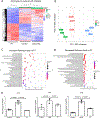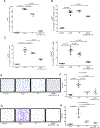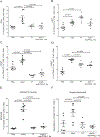Transfusion of Adult, but Not Neonatal, Platelets Promotes Monocyte Trafficking in Neonatal Mice
- PMID: 36951062
- PMCID: PMC11419309
- DOI: 10.1161/ATVBAHA.122.318162
Transfusion of Adult, but Not Neonatal, Platelets Promotes Monocyte Trafficking in Neonatal Mice
Abstract
Background: Thrombocytopenia is common in preterm neonates. Platelet transfusions are sometimes given to thrombocytopenic neonates with the hope of reducing the bleeding risk, however, there are little clinical data to support this practice, and platelet transfusions may increase the bleeding risk or lead to adverse complications. Our group previously reported that fetal platelets expressed lower levels of immune-related mRNA compared with adult platelets. In this study, we focused on the effects of adult versus neonatal platelets on monocyte immune functions that may have an impact on neonatal immune function and transfusion complications.
Methods: Using RNA sequencing of postnatal day 7 and adult platelets, we determined age-dependent platelet gene expression. Platelets and naive bone marrow-isolated monocytes were cocultured and monocyte phenotypes determined by RNA sequencing and flow cytometry. An in vivo model of platelet transfusion in neonatal thrombocytopenic mice was used in which platelet-deficient TPOR (thrombopoietin receptor) mutant mice were transfused with adult or postnatal day 7 platelets and monocyte phenotypes and trafficking were determined.
Results: Adult and neonatal platelets had differential immune molecule expression, including Selp. Monocytes incubated with adult or neonatal mouse platelets had similar inflammatory (Ly6Chi) but different trafficking phenotypes, as defined by CCR2 and CCR5 mRNA and surface expression. Blocking P-sel (P-selectin) interactions with its PSGL-1 (P-sel glycoprotein ligand-1) receptor on monocytes limited the adult platelet-induced monocyte trafficking phenotype, as well as adult platelet-induced monocyte migration in vitro. Similar results were seen in vivo, when thrombocytopenic neonatal mice were transfused with adult or postnatal day 7 platelets; adult platelets increased monocyte CCR2 and CCR5, as well as monocyte chemokine migration, whereas postnatal day 7 platelets did not.
Conclusions: These data provide comparative insights into adult and neonatal platelet transfusion-regulated monocyte functions. The transfusion of adult platelets to neonatal mice was associated with an acute inflammatory and trafficking monocyte phenotype that was platelet P-sel dependent and may have an impact on complications associated with neonatal platelet transfusions.
Keywords: P-selectin; blood platelets; mice; monocytes; platelet transfusion.
Conflict of interest statement
Figures






Comment in
-
Platelet Transfusions in Neonates: Beyond Hemostasis.Arterioscler Thromb Vasc Biol. 2023 Jun;43(6):886-888. doi: 10.1161/ATVBAHA.123.319252. Epub 2023 May 4. Arterioscler Thromb Vasc Biol. 2023. PMID: 37139838 Free PMC article. No abstract available.
References
-
- Davenport P, Fan HH, Nolton E, Feldman HA, Lorenz V, Canas J, Acosta-Zaldivar M, Yakah W, Arthur C, Martin C, Stowell S, Koehler J, Mager D and Sola-Visner M. Platelet transfusions in a murine model of neonatal polymicrobial sepsis: Divergent effects on inflammation and mortality. Transfusion. 2022. - PMC - PubMed
-
- Gunnink SF, Vlug R, Fijnvandraat K, van der Bom JG, Stanworth SJ and Lopriore E. Neonatal thrombocytopenia: etiology, management and outcome. Expert Rev Hematol. 2014;7:387–95. - PubMed
-
- Baer VL, Lambert DK, Henry E, Snow GL, Sola-Visner MC and Christensen RD. Do platelet transfusions in the NICU adversely affect survival? Analysis of 1600 thrombocytopenic neonates in a multihospital healthcare system. J Perinatol. 2007;27:790–6. - PubMed
Publication types
MeSH terms
Grants and funding
LinkOut - more resources
Full Text Sources
Molecular Biology Databases
Miscellaneous

